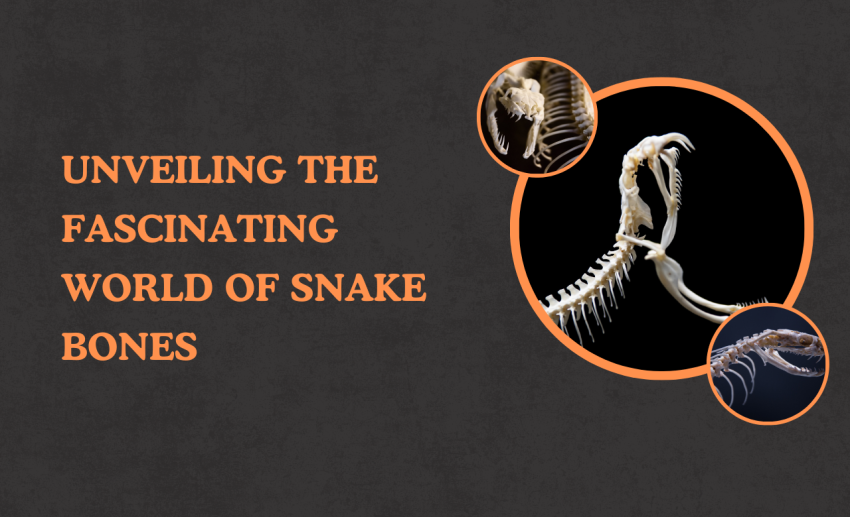Unveiling The Fascinating World Of Snake Bones

Snakes have long captivated human imagination with their sleek, sinuous bodies and enigmatic behaviors. Among the many intriguing aspects of these remarkable reptiles is their skeletal structure. Snake bones, often overlooked in favor of their more visible features, offer a window into the incredible adaptations that have allowed these creatures to thrive in diverse environments across the globe. In this blog post, we'll dive deep into the world of snake bones, exploring their structure, function, and the evolutionary marvels that make them unique.
Anatomy of Snake Bones
The Basics of Snake Skeletons
Unlike mammals, whose bones are relatively rigid and uniform, snake bones are highly specialized to support their elongated bodies and slithering movement. A typical snake skeleton consists of over 200 vertebrae, each connected by a series of flexible joints. This incredible number of vertebrae grants snakes their characteristic flexibility and agility.
The Skull: A Masterpiece of Evolution
The snake's skull is a marvel of evolutionary engineering. Unlike the rigid skulls of mammals, snake skulls are composed of numerous loosely connected bones. This unique structure allows them to consume prey much larger than their own heads. The lower jaw is not fused at the chin, permitting each side to move independently, while the upper jaw is equipped with specialized teeth designed to grip and swallow prey efficiently.
Vertebrae and Ribs: The Backbone of Mobility
The vertebrae and ribs are the most numerous bones in a snake's body. Each vertebra is equipped with a pair of ribs, which protect the snake's vital organs and assist in locomotion. These bones are connected by highly flexible joints, allowing snakes to twist, coil, and constrict with astonishing precision.
The Tail: More Than Meets the Eye
While the tail may seem like a simple extension of the body, it plays a crucial role in a snake's life. The tail vertebrae are typically more robust and less flexible than those in the rest of the body, providing stability and support. In some species, the tail is also a defensive weapon, used to deter predators or attract mates through various displays.
The Functionality of Snake Bones
Locomotion: The Art of Slithering
One of the most remarkable aspects of snake bones is their role in locomotion. Snakes utilize a variety of movements, including lateral undulation, sidewinding, and rectilinear motion, each requiring different bone and muscle coordination. The flexibility of their vertebrae and the absence of limbs enable them to navigate complex terrains, from dense forests to arid deserts.
Feeding Mechanisms: A Jaw-Dropping Feat
The snake's skeletal structure is perfectly adapted for their unique feeding habits. The kinetic skull, with its loosely connected bones, allows snakes to consume prey much larger than their heads. This adaptation is particularly evident in constrictor species, which use their powerful body muscles to subdue prey before swallowing it whole. The snake's jaw can stretch wide open, thanks to the quadrate bone, which acts as a hinge, and the elastic ligaments that connect the jawbones.
Adaptations for Survival: Armor and Camouflage
Snake bones also play a crucial role in defense and camouflage. The ribs, for instance, can expand to make the snake appear larger when threatened, while the coloration and patterning on the scales often mimic the environment, providing a form of passive defense. Additionally, some species have evolved specialized bone structures, such as spines or rattles, to deter predators or signal their presence.
Evolutionary Wonders: How Snake Bones Evolved
From Lizard to Snake: A Journey Through Time
The evolution of snake bones is a fascinating tale of adaptation and survival. Scientists believe that snakes evolved from lizard-like ancestors around 100 million years ago. This evolutionary process involved significant changes in bone structure, including the elongation of the body and the reduction or loss of limbs. Fossil evidence provides valuable insights into these transitional forms, showcasing the gradual adaptations that led to modern snakes.
Specialized Adaptations: Convergence and Divergence
Throughout their evolutionary history, snakes have developed a variety of specialized adaptations to thrive in different environments. Some species, like the burrowing sand boas, have evolved shorter, sturdier bones to navigate underground tunnels, while others, like the arboreal tree snakes, possess elongated, slender bones for climbing. These adaptations highlight the incredible versatility of the snake skeletal system.
Fossil Discoveries: Unearthing the Past
Paleontologists continue to uncover fascinating fossil specimens that shed light on the evolutionary history of snakes. Notable discoveries include the remains of ancient snakes with vestigial limbs, providing a glimpse into the transitional stages of limb reduction. These fossils not only deepen our understanding of snake evolution but also underscore the dynamic nature of vertebrate skeletal adaptations.
The Intriguing World of Snake Bone Research
Technological Advances: Peering Inside
Modern technology has revolutionized the study of snake skull. Advanced imaging techniques, such as CT scans and 3D modeling, allow scientists to examine the internal structures of snake skeletons in unprecedented detail. These tools provide valuable insights into the biomechanics of snake movement, feeding, and other behaviors.
Conservation and Snake Bones
Understanding the skeletal structure of snakes is not just of academic interest but also has important conservation implications. Many snake species face threats from habitat loss, climate change, and human activities. By studying their skeletal adaptations, researchers can better assess the ecological roles of different species and develop strategies for their protection.
Future Directions: Unlocking More Secrets
The study of snake bones is a dynamic field, with new discoveries continually expanding our knowledge. Future research may uncover even more intricate details about how snakes have adapted to their environments and how their skeletal structures continue to evolve. This ongoing exploration promises to reveal further insights into the fascinating world of these remarkable reptiles.
Conclusion The Marvel of Snake Bones
Newman Art Designs Snake bones are a testament to the incredible adaptability and diversity of life on Earth. From their specialized skulls to their flexible vertebrae, these structures enable snakes to navigate their environments with grace and efficiency. As we continue to explore the intricacies of snake anatomy, we gain a deeper appreciation for the evolutionary marvels that have shaped these extraordinary creatures. So, the next time you encounter a snake, take a moment to marvel at the hidden world of bones that supports its every move.
